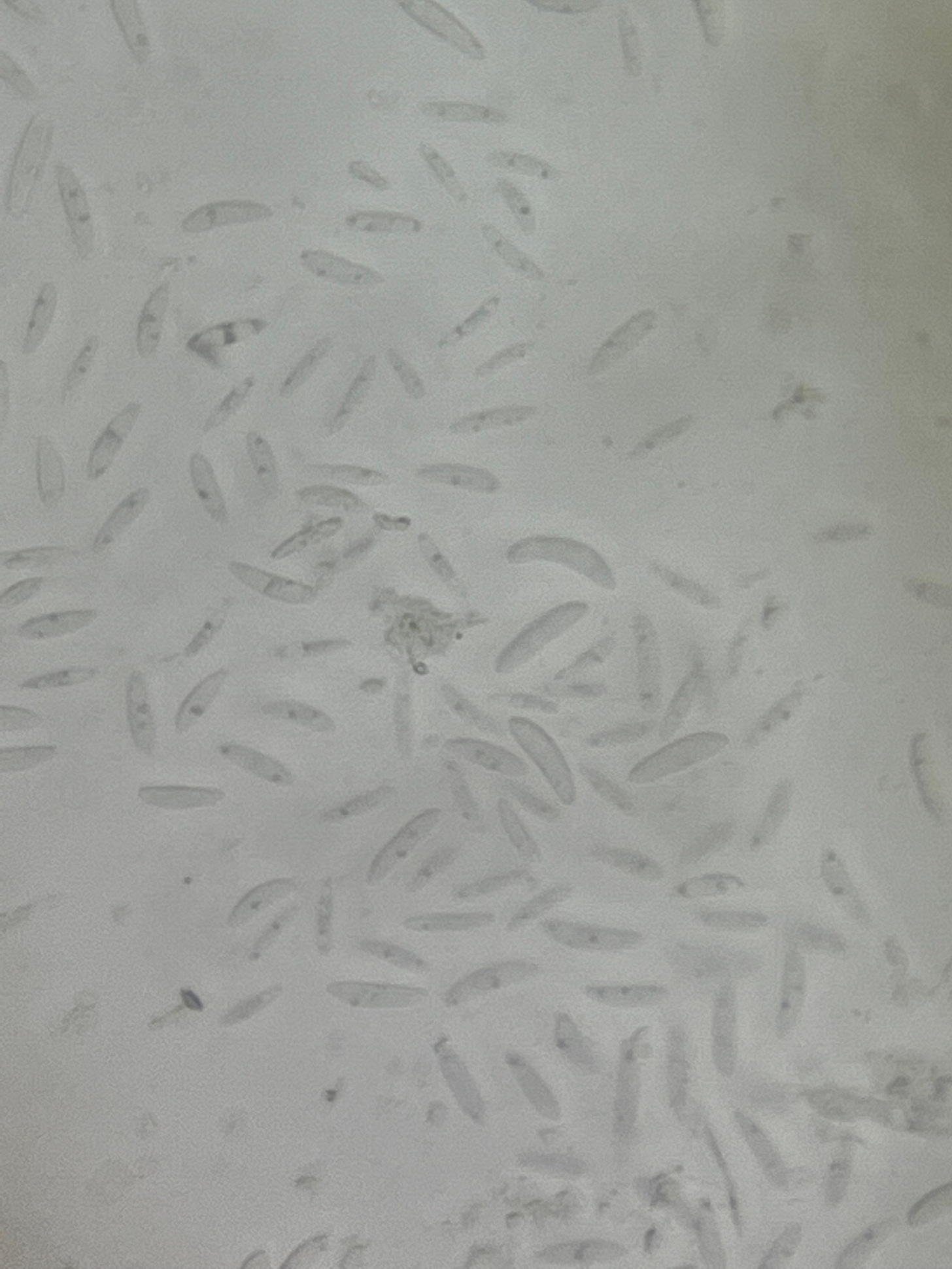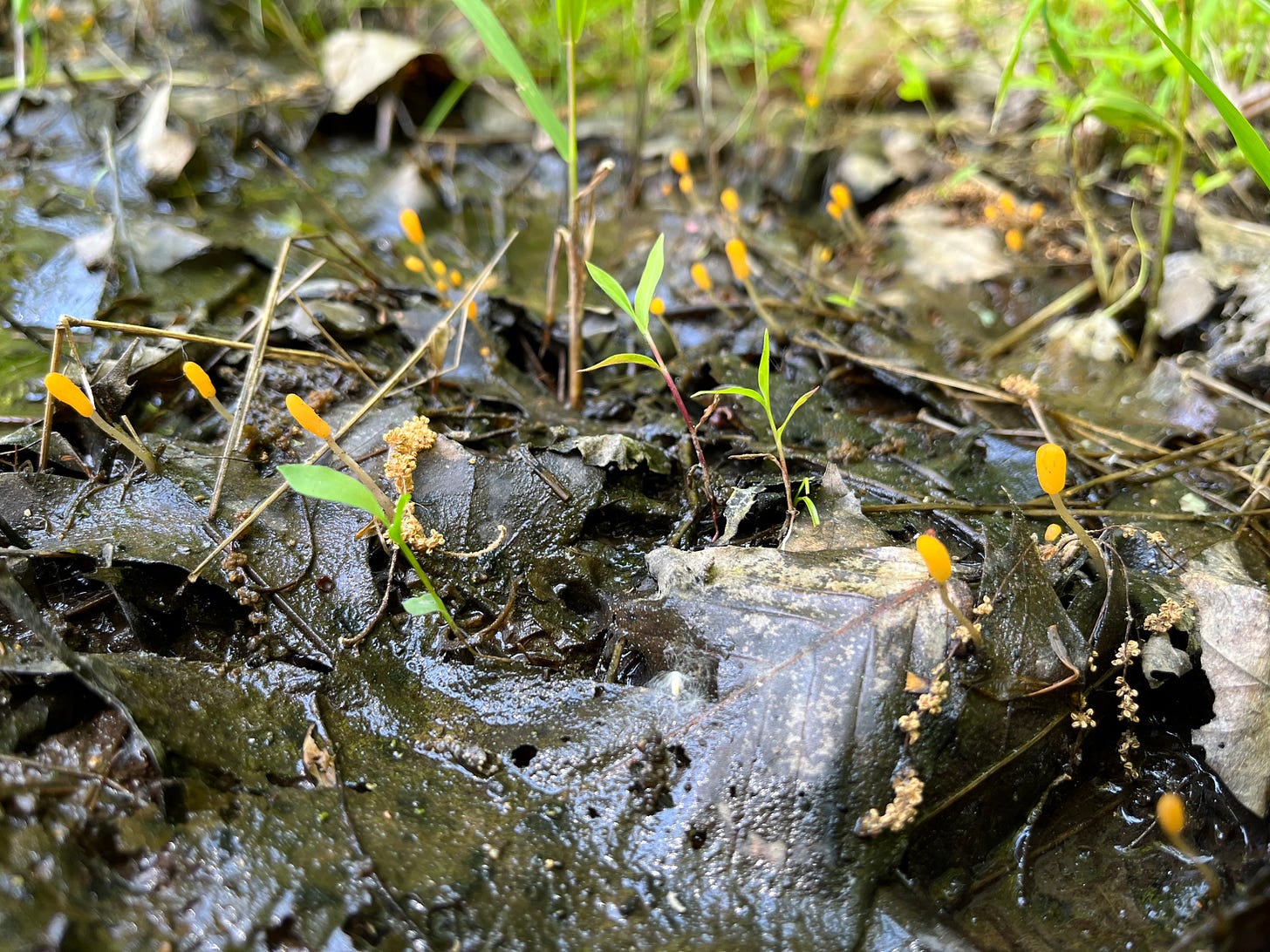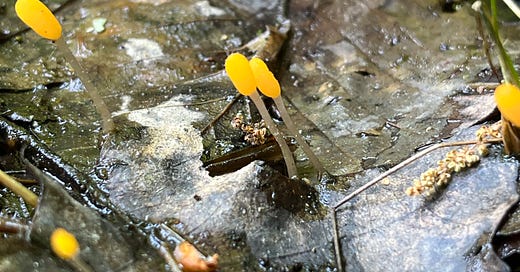Good evening, friends, and Happy Memorial Day!
Thank you to everyone who showed up for the walk yesterday. Dry as it was, we still learned a few things (I hope) and found some gilled fungi. With no rain in the ten day forecast it’s starting to feel like we’ve picked up where we left off last summer with the lack of precip. Regardless, that didn’t stop me this AM when I went on a walk with my mommy in Fahnestock State Park and we found this week’s mushroom, the Swamp Beacon (Mitrula sp.). I saw them last week and didn’t get enough photos, but fate reintroduced us today and I made sure to get everything we need for this week’s MM.
The species that appears in northeastern mushroom books is Mitrula elegans, but you can’t confirm the identity of the specific species without looking at the spores under a microscope. I tried to examine a specimen under a microscope but I struggle with finding ascomycete spores under the scope. Regardless, let’s learn a little more about this flashy fenland fungus and where you might be able to find them.

Mitrula species can grow in shallow, standing water along the sides of creeks and other wetland areas. An amphibious fungus. A study noted that these anaerobic conditions were unsuitable for basidiomycetes - the big, gregarious mushrooms we love to find - and that 75% of the biomass covering the underwater detritus was the mycelium of ascomycete fungi. Mitrula, and other “ascos”, are able to digest this pond scum and cycle the nutrients back into the ecosystem for other plants and animals to use.

There was an additional study that looked at ericoid fungi - fungi that create mycorrhizal relationships with plants in the family Ericaceae. Blueberries (Vaccinium) and mountain laurel (Kalmia latifolia) were two of the most populous plants in the wetland area surrounding the swamp beacons and they’re both in the family Ericaceae. What tied it all together for me was the study found some of the ericoid fungi could both be a “root symbiont” - a mycorrhizal partner - and a decomposer of organic material. The study noted fungi in the Order Helotiales - which includes the genus Mitrula - were both symbiont/decomposers but it didn’t specifically look at any Mitrula species. Regardless, there’s a possibility that these swamp beacons are decomposing old leaves while simultaneously forming symbiotic relationships with the nearby blueberry bush. What a world.
Mitrula comes from Latin and means “little headband” or “bandage” which refers to the club shaped fruiting body (the apothecium). The species epithet elegans means “handsome” or “polite”, and you won’t get any arguments from me if you describe them as such. As my great aunt would say, “they’re darling”.
Mitrula species pop up throughout North America and Europe, but none have been found in NYC. The nearest sighting on iNaturalist is just up in White Plains which makes me think they could definitely be found in Pelham Bay, Van Cortlandt, Alley Pond, or some of the other large, outer borough parks. The little beacons pop up in the spring so this is the time to check the watering hole in your local forest or park.
M. elegans has that distinct, bright yellow apothecium and a white/translucent stipe but they don’t tend to get larger than a few centimeters so keep your eyes peeled. They also will return in the same spot spring after spring since the mycelium is perennially helping to turn the brown leaves of the fall into the vibrant green leaves of the spring.
Toadstool Tuesday?
Folks, I’ve sent out a Mushroom Monday email every Monday for over two and a half years now. Over 125 consecutive Mondays. That’ll end next week because I’m taking a six week plant propagation class at the New York Botanical Gardens that will meet on Monday evenings. The newsletter will get temporarily bumped back a day and we’ll get summer underway with a new mushroom every Tuesday. The show goes on.
Full moon on Saturday night,
Aubrey
References
Wang Z, Binder M, Hibbett DS. Life history and systematics of the aquatic discomycete Mitrula (Helotiales, Ascomycota) based on cultural, morphological, and molecular studies. Am J Bot. 2005 Sep;92(9):1565-74. doi: 10.3732/ajb.92.9.1565. PMID: 21646174.
Vohník M, Réblová M. Fungi in hair roots of Vaccinium spp. (Ericaceae) growing on decomposing wood: colonization patterns, identity, and in vitro symbiotic potential. Mycorrhiza. 2023 Mar;33(1-2):69-86. doi: 10.1007/s00572-023-01101-z. Epub 2023 Jan 26. PMID: 36700963; PMCID: PMC9938075.
https://slocanswamp.files.wordpress.com/2016/07/the-swamp-beacon.pdf







